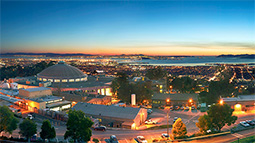National Labs, Profiles, and Contacts
The DOE National Labs address large scale, complex research and development challenges with a multidisciplinary approach that places an emphasis on translating basic science to innovation. To learn more about these world-class facilities or to explore collaborative SBIR/STTR opportunities, please contact the facility point of contact listed below.
What is the Value of Working with the Federal Laboratories?
We have prepared a short tutorial to learn more about The Value of Working with a Federal Laboratory. The focus of this tutorial is on a subset of the Federal Labs referred to as Federally Funded Research and Development Centers or FFRDCs. The 16 DOE National Labs listed below are FFRDCs.
The guide to partnering with DOE’s National Laboratories and Facilities contains instructions and other useful resources to help industry to partner with the labs to access their unique capabilities, note that not all technology transfer mechanisms are available at each of the laboratories. Please contact the laboratory that you are interested in partnering with for additional information.
National Lab Strategic Partnership Project SBIR/STTR Agreement Template
Are you looking to engage with one of DOE’s national laboratories during your Phase I SBIR or STTR project? Several of the DOE labs, including the Ames Laboratory, Argonne National Laboratory (ANL), Brookhaven National Laboratory (BNL), Fermi National Accelerator Laboratory, Idaho National Laboratory (INL), National Renewable Energy Laboratory (NREL), Oak Ridge National Laboratory (ORNL) and Pacific Northwest National Laboratory (PNNL) have streamlined this engagement process for SBIR and STTR firms. Here you’ll find the U. S. Department of Energy’s approved, non-negotiable Strategic Partnership Project (SPP) SBIR/STTR Agreement template to be used for these Laboratories.
Looking for Partners?
In July 2021, the SBIR/STTR programs office added a Tech to Market (T2M) Advisor, Carol Rabke, to help DOE SBIR/STTR awardees and applicants build the necessary relationships at each step of the development path. Visit our new Partnering Resources page!
Look for an SBIR/STTR partnering website to be unveiled in July 2023. In the interim, reach out to Carol to discuss any specific partnering needs.

Ames National Laboratory
Core Competencies
- Applied Materials Science and Engineering
- Chemical and Molecular Science
- Condensed Matter Physics and Materials Science
Contact
Julienne Krennrich, (515) 294-1202, jmkrenn@ameslab.gov
Argonne National Laboratory
Core Capabilities
- Accelerator Science and Technology
- Applied Mathematics
- Advanced Computer Science, Visualization, and Data
- Applied Nuclear Science and Technology
- Applied Materials Science and Engineering
- Chemical and Molecular Science
- Chemical Engineering
- Condensed Matter Physics and Materials Science
- Large Scale User Facilities / Advanced Instrumentation
- Nuclear Physics
- Particle Physics
- Systems Engineering and Integration
Major User Facilities
- Advanced Photon Source (APS)
- Argonne Leadership Computing Facility (ALCF)
- Center for Nanoscale Materials (CNM)
- Electron Microscopy Center (EMC)
- Argonne Tandem Linac Accelerator System (ATLAS)
- ARM Climate Research Facility
Contact
Cynthia Wesolowski, (630) 252-7694, weso@anl.govKaren Neumann, (630) 252-9124, kneumann@anl.gov

Brookhaven National Laboratory
Core Competencies
- Design, engineering, and operation of accelerators, detectors, and superconducting magnets
- The physics of energy and matter, the chemistry and physics of materials and condensed matters, chemical energy sciences, bio-medical and imaging sciences, energy and environmental sciences and technologies, and systems analysis and modeling
Major User facilities
- Relativistic Heavy Ion Collider, the world’s newest accelerator for nuclear physics
- National Synchrotron Light Source, which provides researchers with intense light spanning the electromagnetic spectrum from the infrared through x-rays
- Alternating Gradient Synchrotron, home of three Nobels and pivotal physics discoveries
- Scanning Transmission Electron Microscope, used to reveal the structure and function of proteins, nucleic acids, and other macromolecules, and to image single heavy atoms
- Accelerator Test Facility, the U.S. proving ground for new concepts in accelerator physics
- Booster Applications Facility, designed to use heavy ion beams for space radiation studies
- Center for Functional Nanomaterials, now under construction, will provide researchers with state-of-the-art capabilities to fabricate and study nanoscale materials
Contacts
- Erick Hunt, (631) 344-2103, ehunt@bnl.gov
- Ginny Coccorese, (631) 344-2506, vcoccorese@bnl.gov
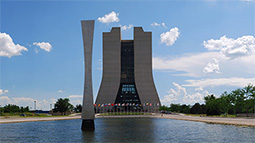
Fermi National Accelerator Laboratory
Core Competencies
- Operation of the world’s highest-energy physics user facility
- Accelerator research, design, construction, and operation
- Superconducting magnet research, design, and development
- Superconducting Radio Frequency Accelerating Cavity research, design, and development
- Particle detector design and operation
- High-performance computing and networking
- International scientific collaboration
- Construction and management of scientific and technical projects
- Scientific training and education, all levels
Major User Facility
Fermilab Accelerator Complex, which produces the world’s most powerful, high-energy neutrino beam and provides proton beams for various experiments and R&D programs.
Contact
Cherri Schmidt (630) 840-5178 cherri@fnal.gov
Robert Kephart (630) 840-3135 kephart@fnal.gov

Idaho National Laboratory
Core Competencies
- Nuclear Science User Facilities
- Biomass Feedstock National Scientific User Facility
- Wireless National User Facility
USER FACILITIES
- Analytical Laboratory
- Fuels and Applied Science Building
- Irradiated Materials Characterization Lab
- Space & Security Power Systems Facility
- Hot Fuel Examination Facility
- Fuel Conditioning Facility
- Transient Reactor Test Facility
- Experimental Fuels Facility
- Additional MFC capabilities
Contact
Stephanie Cook, 208.526.1644, stephanie.cook@inl.govLawrence Berkeley National Laboratory
Core Competencies
- Accelerator Science
- Advanced Computer Science, Visualization, and Data
- Applied Materials Science and Engineering
- Applied Mathematics
- Applied Nuclear Science and Technology
- Biological Systems Science
- Chemical and Molecular Science
- Chemical Engineering
- Climate Change Science
- Computational Science
- Condensed Matter Physics and Materials Science
- Environmental Subsurface Science
- Large Scale User Facilities/Advanced Instrumentation
- Nuclear Physics
- Particle Physics
- Systems Engineering and Integration
Major User Facilities
- Advanced Light Source (ALS)
- Molecular Foundry
- Joint Genome Institute (JGI)
- National Energy Research Computing Center (NERSC)
- Energy Sciences Network (ESnet)
- National Center for Electron Microscopy (NCEM)
- ARM Climate Research Facility
Contact
Shanshan Li 510-486-5366, shanshanli@lbl.gov

Lawrence Livermore National Laboratory
Core competencies:
- Nuclear and Isotopic Science and Technology
- High Energy Density Science
- High Performance Computing, Simulation, and Data Science
- Advanced Materials and Manufacturing
- Laser and Optical Science and Technology
- Bio-Science and Bio-Engineering
- Earth and Atmospheric Science
Major User Facilities:
National Ignition Facility – The largest, most-energetic laser facility in the world.- Terascale Simulation Facility – Home to some of the world’s fastest computers, including Sequoia (20 petaflops) and Vulcan (5 petaflops).
- National Atmospheric Release Advisory Center (NARAC) – National resource for predicting the spread of airborne releases of hazardous materials.
- Forensic Science Center – Nationally recognized forensic analysis capabilities in support of nuclear, chemical, explosives and biological counterterrorism.
- High Explosive Applications Facility (HEAF) – State-of-the-art research facility for formulating, characterizing, processing and testing energetic materials.
- Site 300 – Remote site for high explosives and environmental testing.
- Center for Accelerator Mass Spectrometry (CAMS) – Worlds’most versatile and productive accelerator and mass spectrometry facility.
- Livermore Valley Open Campus (LVOC) – An open, unclassified research and development space to connect industry and academia with laboratory expertise to advance high performancecomputing, energy and environmental security, cyber security, economic security and non-proliferation.
- Center for Micro and Nano-Technologies (CMNT) - The center has been a leader in fueling the commercial growth of micro- and nano-technologies while simultaneously customizing these same technologies for unique, noncommercial applications specific to the Laboratory and DOE.
- Additive Manufacturing (AM) – Often referred to as 3D printing, LLNL is developing AM technologies to achieve its missions with DOE, DOD and DHS as well as in development of its energy applications. LLNL is also collaborating with U.S. manufacturers to assist them to become more competitive in the global marketplace.
Contact
Connie Pitcock pitcock1@llnl.gov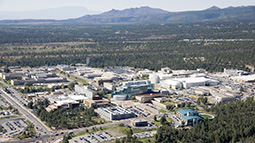
Los Alamos National Laboratory
Core Competencies
- Accelerators, Electrodynamics
- Bioscience, Biosecurity, Health
- Chemical Science
- Earth & Space Sciences
- Engineering
- Information Science, Computing , Applied Math
- Materials Science
- National Security, Weapons Science
- Sensors & Instrumentation
- Nuclear & Particle Physics, Astrophysics, Cosmology
Major User Facilities
- Center for Integrated Nanotechnologies (CINT): a facility for discovering the scientific principles that govern the design, performance, and integration of nanoscale materials; with Sandia National Laboratories.
- Neutron and Nuclear Science Facility (WNR): provides neutron and proton beams and detector arrays for basic, applied, industrial, and defense-related research.
- National High Magnetic Field Laboratory: a general user facility open to all researchers who wish to perform experiments in high magnetic fields.
Contacts
- Ian Foti-Landis, (505) 667-1710, sbir-sttr@lanl.gov
- MaryAnn Morgan, (505) 667-5324, sbir-sttr@lanl.gov
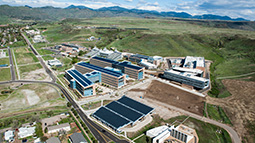
National Renewable Energy Laboratory
Core Competencies
- Renewable electricity production and use
- Renewable fuels formulation and use
- Integrated energy system engineering and testing
- Strategic energy analysis
Contact
- Tom Williams, (303) 275-4485, Tom_Williams@nrel.gov
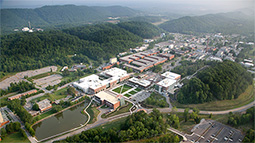
Oak Ridge National Laboratory
Core Competencies
- Accelerator Science
- Advanced Computer Science, Visualization, and Data
- Applied Materials Science and Engineering
- Applied Nuclear Science and Technology
- Biological Systems Science
- Chemical and Molecular Science
- Chemical Engineering
- Climate Change Science
- Computational Science
- Condensed Matter Physics and Materials Science
- Environmental Subsurface Science
- Large Scale User Facilities/Advanced Instrumentation
- Nuclear Physics
- Particle Physics
- Plasma and Fusion Energy Science
- Systems Engineering and Integration
Major User Facilities
- Building Technologies Research & Integration Center (BTRIC)
- Center for Nanophase Materials Sciences (CNMS)
- Center for Structural Molecular Biology (CSMB)
- Carbon Fiber Technology Facility (CFTF)
- High Flux Isotope Reactor (HFIR)
- Manufacturing Demonstration Facility (MDF)
- National Transportation Research Center (NTRC)
- Oak Ridge Leadership Computing Facility (OLCF)
- Spallation Neutron Source (SNS)
Contact
Mark Reeves: (865)576-2577, reevesme@ornl.gov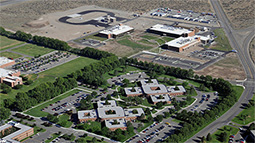
Pacific Northwest National Laboratory
Core Competencies
- Microbial and cellular biology
- Environmental sciences
- Analytical and interfacial chemical sciences
- Radiological sciences
- Information analytics
- Sensing and measurement technologies
Major User Facilities
- William R. Wiley Environmental Molecular Sciences Laboratory, a U.S. Department of Energy (DOE) national user facility, currently shared and used by researchers from around the world. Research at EMSL focuses principally on developing a molecular-level understanding of the physical, chemical, and biological processes that underlie the most critical environmental issues facing DOE. Located on PNNL’s campus.
- Applied Process Engineering Laboratory is an eastern Washington technology business startup user facility, supported in part by PNNL. APEL provides engineering- and manufacturing-scale space and chemical, biological, and electronic laboratories and equipment for developing, validating, and commercializing new products. Entrepreneurs, engineers, scientists, and university staff can access this facility. PNNL scientists, engineers, and other professional staff are available to APEL occupants for consulting, collaboration, or professional support.
- Bioproducts, Sciences, and Engineering Laboratory is a joint effort between Washington State University (WSU) and PNNL. Located on the WSU Tri-Cities campus in Richland, Washington, researchers use the laboratory to develop technology for converting low-value agricultural byproducts and residues into value-added chemicals for products like plastics, solvents, fibers, pharmaceuticals, fuels, and fuel additives.
Contact
- Robin Conger, (509) 372-4328, robin.conger@pnnl.gov
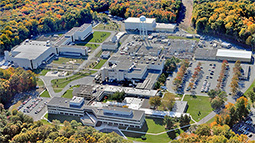
Princeton Plasma Physics Laboratory
Core Competencies
- Experimental analysis of stability and confinement of fusion plasmas
- Plasma theory and computational physics for fusion and other applications
- Physics and engineering design and operation of experimental plasma fusion facilities
- Computer engineering, including data acquisition, instrumentation, and control systems
- Physics and technology of plasma applications to advance industrial technologies
- Environmental, safety, and health aspects of the operation and removal of experimental fusion devices
Major User Facilities
- National Spherical Torus Experiment (NSTX), to advance knowledge for the spherical torus plasma confinement concept
- National Compact Stellarator Experiment (NCSX), a device to study a compact stellarator confinement concept, for which a preliminary design is under way. Construction began in 2004.
- Current Drive Experiment-Upgrade (CDX-U), to investigate plasma interactions with liquid lithium for fusion reactor technology.
- Magnetic Reconnection Experiment (MRX), to study the breaking and reconnection of magnetic field lines in plasmas
Contact
- Lewis Meixler, (609) 243-3009, lmeixler@pppl.gov
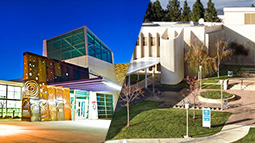
Sandia National Laboratories
Core Competencies
- Bioscience
- Computing and information science
- Engineering science
- Geoscience
- Materials science
- Nanodevices and microsystems
- Radiation effects and high energy density science
Major User Facility
The 25 user facilities and technology deployment centers at Sandia include:- Combustion Research Facility, which conducts a broad range of basic and applied research and development in combustion science and technology, aimed at improving the nation’s ability to use and control combustion processes
- Explosives Components Facility, a state-of-the-art facility that provides a full range of chemical, material, and performance analysis capabilities for energetic materials and explosive components
- Intelligent Systems and Robotics Center, which contains the Robotic Manufacturing Science and Engineering Laboratory, a 73,000-square-foot facility built to bring together all of Sandia’s robotics researchers in an environment conducive to technology transfer Primary Standards Facility, assures the accuracy of measurements for customers by certifying standards, developing measurement techniques, and advancing the state of the art in metrology, the science that deals with measurement
- Shock Technology and Applied Research Facility, a state-of-the-art facility that can provide a full range of projectile/target interactions
Contact
- Ann J. Riley, (505) 284-9550, (800) 765-1678, ajriley@sandia.gov supplier@sandia.gov

Savannah River National Laboratory
Core Competencies
- Waste processing
- Environmental science
- Nonproliferation and national security
- Spent nuclear fuel
- Nuclear materials management
- Hydrogen technology
Contact
- Dale Haas, (803) 725-4185, dale.haas@srnl.doe.gov
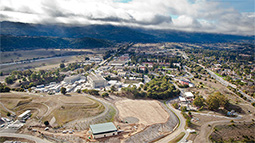
SLAC National Accelerator Laboratory
Core competencies:
- Accelerators
- Detectors
- High-throughput data acquisition
- Big Data computation and visualization
- X-rays
- Lasers
- X-ray free-electron lasers
- Materials science
- Chemical science
- Bioscience
- Matter in extreme conditions
- Batteries
- Solar energy
- Catalysis
- Smart grid
- Dark matter
- Dark energy
- Cosmic inflation
- Particle physics
Major user facilities:
- Linac Coherent Light Source (LCLS), the world’s first hard X-ray free-electron laser. It provides ultrashort, high-energy pulses, a billion times brighter than those previously available at synchrotrons, at a rate of up to 120 per second.
- Stanford Synchrotron Radiation Lightsource (SSRL) produces bright X-ray light for probing matter at the atomic and molecular level.
Contact
Matt Garrett sbir@slac.stanford.edu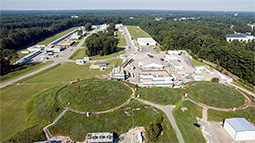
Thomas Jefferson National Accelerator Facility
Core Competencies
- Experimental nuclear physics
- Nuclear theory
- High-energy physics
- Advanced accelerator research
- Synchrotron radiation research
- Astroparticle physics
- Technology and education
- Energy Recoverable Linacs
- Cryogenics
- Superconducting RF Technology
- Radiation Detector and Imaging Technology
Major User Facilities
- Continuous Electron Beam Accelerator Facility, a continuous-wave, recently upgraded to deliver 12 billion electron volt (12 GeV) beam once commissioning is complete. The CEBAF Accelerator is capable of delivering polarized electron beams to three separate end stations simultaneously.
- Free-Electron Laser (FEL), a superconducting radio-frequency-(srf)-based laser that has delivered 14.2 kilowatt (kW) of infrared light and provided proof of principle for srf energy recovered linacs.
Contacts
- Dr. Drew Weisenberger, (757) 269-7090, drew@jlab.org

